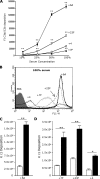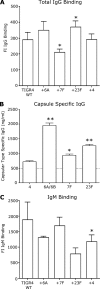Streptococcus pneumoniae resistance to complement-mediated immunity is dependent on the capsular serotype
- PMID: 19948838
- PMCID: PMC2812205
- DOI: 10.1128/IAI.01056-09
Streptococcus pneumoniae resistance to complement-mediated immunity is dependent on the capsular serotype
Abstract
Streptococcus pneumoniae strains vary considerably in the ability to cause invasive disease in humans, and this is partially associated with the capsular serotype. The S. pneumoniae capsule inhibits complement- and phagocyte-mediated immunity, and differences between serotypes in these effects on host immunity may cause some of the variation in virulence between strains. However, the considerable genetic differences between S. pneumoniae strains independent of the capsular serotype prevent an unambiguous assessment of the effects of the capsular serotype on immunity using clinical isolates. We have therefore used capsular serotype-switched TIGR4 mutant strains to investigate the effects of the capsular serotype on S. pneumoniae interactions with complement. Flow cytometry assays demonstrated large differences in C3b/iC3b deposition on opaque-phase variants of TIGR4(-)+4, +6A, +7F, and +23F strains even though the thicknesses of the capsule layers were similar. There was increased C3b/iC3b deposition on TIGR4(-)+6A and +23F strains compared to +7F and +4 strains, and these differences persisted even in serum depleted of immunoglobulin G. Neutrophil phagocytosis of the TIGR4(-)+6A and +23F strains was also increased, but only in the presence of complement, showing that the effects of the capsular serotype on C3b/iC3b deposition are functionally significant. In addition, the virulence of the TIGR4(-)+6A and +23F strains was reduced in a mouse model of sepsis. These data demonstrate that resistance to complement-mediated immunity can vary with the capsular serotype independently of antibody and of other genetic differences between strains. This might be one mechanism by which the capsular serotype can affect the relative invasiveness of different S. pneumoniae strains.
Figures






References
-
- Austrian, R. 1981. Some observations on the pneumococcus and on the current status of pneumococcal disease and its prevention. Rev. Infect. Dis. 3(Suppl.):S1-S17. - PubMed
Publication types
MeSH terms
Substances
Grants and funding
LinkOut - more resources
Full Text Sources

